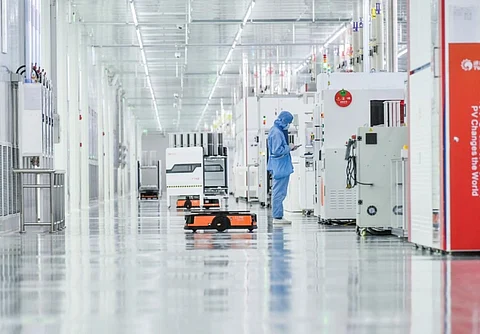

The Sichuan Province Crystalline Silicon Photovoltaic Technology Innovation Center has been officially approved by the Sichuan Provincial Department of Science and Technology. The center is co-founded by Tongwei Solar in collaboration with industry players including Cybrid, Fusion, DR Laser, Sunwell, as well as Sichuan University and Southwest Petroleum University. The initiative aims to build an innovation ecosystem integrating industry, academia, and research for the photovoltaic sector, encompassing fundamental and advanced research, proof-of-concept, pilot-scale production, mass production promotion, and industrial expansion. The center’s goal is to achieve high synergy between R&D and industrial innovation.
Tongwei ranks 1st globally in solar cell shipments for 2024 (see Top 5 Solar Cell Suppliers Shipped 163 GW Capacity In 2024) and 5th in module shipments (see Top 10 Solar Module Manufacturers Ship 502 GW In 2024) in the recent PV InfoLink rankings.
Leading solar cell and module manufacturing equipment supplier Autowell has announced that it has successfully secured a bulk order confirmation for HJT 0BB stringer upgrades from an undisclosed photovoltaic industry leader. The upgrade, which adopts a welding + adhesive dispensing process, has a total capacity exceeding 10GW. Autowell stated that to advance the industrialization of 0BB technology, the company has developed an upgrade solution transitioning from the SMBB to the 0BB process. Currently, this upgrade solution is fully compatible with both high-temperature and low-temperature process routes.
In November 2024, Autowell reported a 45.42% YoY increase in its Q3 2024 revenues (see China Solar PV News Snippets).
Solar encapsulation material and hot melt adhesive manufacturer Tianyang New Materials has announced the termination of its annual 150 million m2 PV film manufacturing facility in Kunshan City, Jiangsu Province. The company, which markets its products under the JCC brand name, had initially planned to allocate RMB 90 million ($12.36 million) from the funds raised in its 2022 private placement for this project. However, due to persistently low prices and increased competition, the company determined that the project would not yield expected returns. As a result, Tianyang New Materials decided to cancel the project and reallocate the remaining RMB 34.54 million ($4.75 million) in raised funds toward daily operations and business development. The company had previously announced delays in a few of its projects in November 2024 (see China Solar PV News Snippets).
Italian solar cell and module manufacturer FuturaSun is in discussions with the municipal government of Lingwu City, Yinchuan Province, regarding the establishment of an integrated solar manufacturing base. The project, with an estimated investment of RMB 1.5 billion ($206.04 million), includes the construction of a 5 GW module factory and a 500 MW perovskite module pilot production line.
In 2023, FuturaSun launched a solar cell and module manufacturing project in Huai’an City, Jiangsu Province, with a planned annual capacity of 10 GW for solar cells and 2 GW for modules. The total investment for this project is RMB 5 billion ($687.99 million), and it is being developed in 2 phases. The first phase, a 5 GW cell production facility, was completed at the end of 2024.
China’s Ministry of Industry and Information Technology (MIIT), along with the National Energy Administration (NEA) and other agencies, has jointly released the High-Quality Development Action Plan for the New Energy Storage Manufacturing Industry. The plan sets a target to establish a well-structured new energy storage industry system by 2027, accelerating the efficient development and utilization of renewable energy.
The plan emphasizes the need to accelerate breakthroughs in new energy storage technologies, promoting diversified storage solutions such as lithium-ion batteries, sodium-ion batteries, flow batteries, and compressed air energy storage. It also calls for R&D efforts in smart batteries and thermal/cold energy storage. The plan highlights the integration of “PV + storage” systems into public infrastructure applications, including urban lighting, traffic signals, rural and agricultural applications, public broadcasting, and smart carports. It also encourages the development of micro off-grid storage systems.
